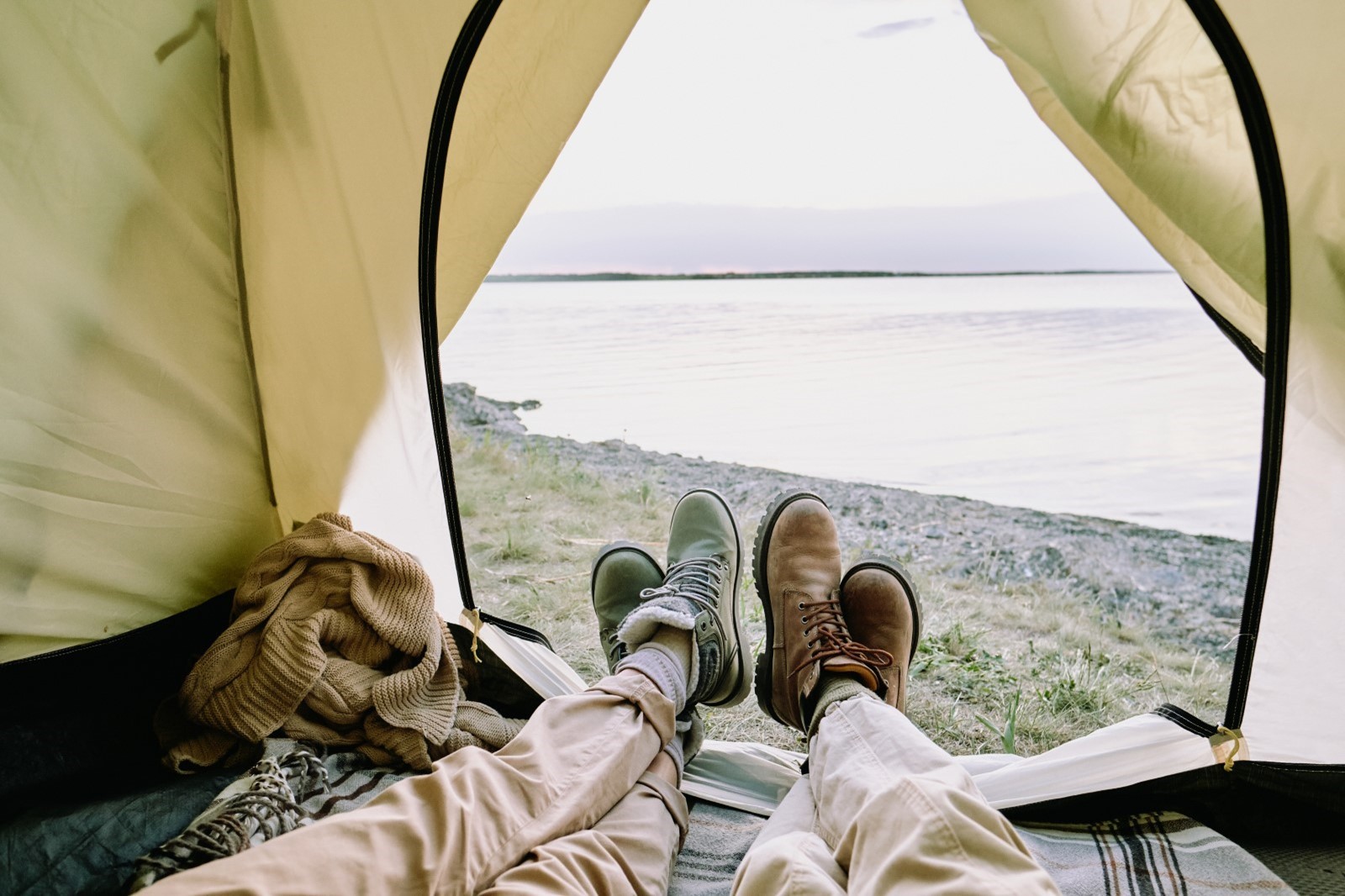This blog post may contain affiliate links. As an Amazon Associate I earn from qualifying purchases.
For me, camping is my way of getting back in touch with nature. Unfortunately, nature can include some unpleasantly high temperatures, which can make my tent feel more like an oven than a shelter.
Being stuck in a hot tent can not only be uncomfortable, but it can also be dangerous. You can risk dehydration, heat stroke, or even a stroke by exposing yourself to high temperatures for extended periods. Combine that risk with the fact you might be in a remote area, and it can get very dangerous.
To make sure that I can stay comfortable and safe during my outdoor adventures, I need to keep my tent cool. In this article, ’m going to share my top tips for regulating the temperature in your tent. So, keep these in mind the next time you plan on traveling somewhere hot!
Choosing the Right Campsite
The first thing to think about is where you will be camping—not just the general region but also the specific camping site and even the placement of your tent on that site.
- Region
Consider the region you are traveling to and the expected weather. Certain areas will simply be unreasonably hot at certain times of the year. If you don’t deal very well with heat, you probably don’t want to plan on going camping in Arizona in July. - Consider the Campsite’s Environment
When you reach your campsite, pick a spot which will have some natural shade during the hottest parts of the day. I often look for a spot under a tree or which will be in the shadow of an overhanging ridge if I’m camping near cliffs. - Position Your Tent for Airflow
Natural ventilation can make a big difference to how warm your tent gets. Set up your tent so that the prevailing breeze flows through it. This will help to move cool air through the tent and keep the temperature low. You can always zip up your tent if it gets too cool.
Proper Tent Selection
Your tent’s design, and the material it is made of, will have a big impact on how well it can regulate heat. Here are my top tips for choosing a tent for hot weather…
- Opt for Tents with Good Ventilation
Ideally, you should look for a tent with ventilation features like large mesh windows and/or vents that can be opened to increase airflow. - Consider Tent Material and Color
Light-colored tents reflect sunlight and heat, keeping the interior cool. You should also pick a tent which is made from a breathable material to allow to airflow. Polycotton (35% premium polyester & 65% cotton) is my go-to choice for a breathable material that is still durable enough. - Tarp or Rainfly Options for Additional Shade
A tarp or rainfly can help to create a shaded area at the front of your tent. This is a place you can retreat to if there is unavoidable direct sunlight on your tent. It can also help to reduce heat buildup in your tent.
Ventilation Strategies
Ventilation is key to keeping your tent cool.
- Utilize Tent Windows and Vents
If your tent has ventilation flaps that can be opened, you should do this. These often have mesh screens, which will prevent insects from getting in. This means you should be able to keep these vents open all night if you need them, without the risk of mosquito bites. - Set Up Cross-Ventilation
To maximize the airflow in your tent, make sure that you open windows or vents of opposite sides of your tent. This is known as cross-ventilation and will allow air to flow through the tent and help reduce the temperature. - Use Portable Fans
I always bring a portable, battery-powered fan with me (as well as some spare batteries). Even a small fan can help a lot in a contained environment like a tent. I recently bought myself a D-cell battery powered fan that can also charge my USB devices.
Accessories and Gear
As well as portable fans, there are some other accessories which can help with cooling your tent. Here are some which I recommend. It might be overboard to pack all of these, unless you really are planning on camping in the Arizona desert in July!
- Cooling Bedding and Sleeping Gear
Just as the material of your tent can affect your temperature, so can the fabric which your bedding and sleeping gear is made of. Invest in some bedding and a sleeping bag that is made from a moisture-wicking material. A gel-filled cooling sleeping pad is also really helpful. - Cooling Towels and Clothing
Your clothing will also have a big impact on your body temperature. Linen is a great choice for keeping you cool. While it might not be the best for hiking, having a linen shirt and some line pants or shorts to change into when you are in your tent is a great idea. - Sunscreen
Use a high-SPF sunscreen when you are outside of your tent. This will help protect against sunburn and heat stroke.
Timing and Planning
The temperature in your tent will vary greatly throughout the day depending on the intensity and direction of sunlight. Take this into account when planning your day.
- Plan Your Activities to Avoid Peak Heat Hours
If you are planning on hiking, you should do this during the early morning or late afternoon to avoid overexerting yourself during peak hours. - Take Midday Breaks Outside of the Tent
It is normally the hottest during the hours of 11am to 2pm. Being in your tent or in direct sunlight during this time can be very intense. Try to find cooler, shaded areas to be during this time. I often bring a hammock with me and try to find a nice spot where I can set it up for exactly this reason. - Cook Outside of Your Tent
The sun isn’t the only source of heat when you are camping. Cooking and campfires also generate a lot of heat. Don’t cook inside your tent. Not only can it be dangerous to do so, but it can also cause a buildup of heat which can take hours to dissipate.
Hydration and Personal Cooling
You need to think about your body temperature, not just the temperature of your tent.
- Drink Plenty of Water
Your hydration plays a key role in regulating your body temperature. Make sure that you are drinking plenty of water to keep yourself hydrated. - Use Personal Cooling Devices and Techniques
Handheld fans, cooling towels, moisture-wicking clothing, and wide-brimmed hats can all help you stay cool during high heat. - Identify Signs of Heat-Related Illnesses
Know the signs and symptoms of heat stroke and heat exhaustion.
| Condition | Symptoms | Steps to Take |
| Heat Exhaustion | Heavy sweating Weakness Dizziness Headache Nausea or vomiting Muscle cramps Cold, pale, clammy skin Fast breathing | Move to a cool place and rest in shade or air conditioning. Loosen clothing and remove excess layers. Drink cool fluids (water or electrolyte drinks) slowly. Apply cool, wet cloths to skin or take a cool bath. If vomiting persists or you don’t improve after 30 minutes, seek medical attention. |
| Heat Stroke | High body temperature (over 104°F/40°C) Hot, red, dry skin (may not sweat) Confusion, disorientation, or staggering Seizure Unconsciousness Rapid, shallow breathing Rapid heartbeat | Call 911 or emergency services immediately. While waiting for help, move the person to a cool place and remove excess clothing. Try to cool the person down with cool water (sponge bath, fanning) DO NOT give fluids unless the person is conscious and able to swallow. |
Final Thoughts – Stay Cool While Camping
As you embark on your camping adventure, remember to be mindful of the expected temperatures in the area you are camping, pack a tent and clothes made from breathable material, stay out of direct sunlight during the hottest parts of the day, and know the symptoms of heat stroke and heat exhaustion.
With these tips and strategies, you can ensure a cool and enjoyable camping experience even in scorching summer conditions. Stay safe, stay comfortable, and make the most of your outdoor adventures. Happy camping!
FAQs
How can I keep my tent cool while camping in hot weather?
To keep your tent cool, choose a shaded campsite with natural airflow, such as under a tree or near a ridge. Position your tent to allow a breeze to pass through it, and consider a light-colored, well-ventilated tent to reduce heat buildup. You can also set up a tarp or rainfly to provide extra shade.
What type of tent is best for hot weather camping?
For hot weather camping, look for a tent with large mesh windows or ventilation flaps to allow cross-ventilation. Light-colored tents made from breathable materials like polycotton are ideal because they reflect heat and enhance airflow. A tarp or rainfly can also help reduce direct sunlight exposure, keeping the tent cooler.
What other gear can help me stay cool while camping?
Besides a well-ventilated tent, bring a portable fan, cooling bedding, and clothing made from moisture-wicking materials. Cooling towels and handheld fans are also helpful for personal cooling, while a high-SPF sunscreen and wide-brimmed hats offer protection from the sun’s heat.
How can I prevent heat-related illnesses while camping?
Stay hydrated by drinking plenty of water, avoid peak heat hours by planning activities for early morning or late afternoon, and recognize symptoms of heat exhaustion or heat stroke. Move to a shaded area during the hottest parts of the day, and avoid cooking inside the tent, as it generates additional heat.


